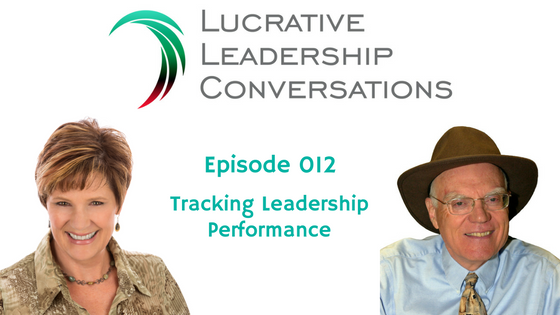012 | Tracking Leadership Performance
Welcome back to the Lucrative Leadership Conversation podcast. In season 1 of the podcast, we have covered the “6 Bold Steps” Gene Morton has developed that allow organizations to become both profitable and sustainable. Today, we discuss how to implement a successful performance tracking system and how it is worth your time and energy.
The 6 Bold Steps provide a strategic pathway for leadership teams to achieve clarity, focus, accountability, and commitment within their organizations.
Here’s a recap of each step along with links to the related episodes:
- In step 1, leaders agree to their own personal responsibilities to ensure decisions protect the organization’s best interest.
- In step 2, they craft a common language, which we call “outcomes, that expresses the core competencies synergistic with the strategic vision.
- In step 3, they negotiate who, on the leadership team, will have the primary accountability for designing and executing each outcome.
- In step 4, Working together, the leaders begin an intuitive process to collaborate and design a structure they are able to support and explain to others. Leaders decide their roles for each outcome and agree how and when communications occur that define future and past actions and decisions. They create the first drafts of the reporting structure.
- In step 5, leaders finish designing a strategic reporting structure. Engaging the entire organization in ongoing discussions improves the design. Conversations serve to clarify and reinforce the meaning of the outcomes that make the organization sustainable.
Most performance management systems focuses conversations on past results.
Failure is a part of the learning and improving process.
You cannot hold people accountable for what they cannot control. Don’t waste energy holding them accountable. It’s too late. Correct the situation and work on determining those accountabilities up front and know who is in charge of what.
The goal of tracking performance is to discover the best practices for the delivery of each outcome to the customer. So, creating a successful performance tracking system (step 6) ties all the way back to defining the organization’s critical outcomes (step 2).
The Importance of Clarifying Critical Outcomes
Clarity within an organization comes from creating and defining the critical outcomes and corresponding accountabilities. A well-formed outcome statement is the compass that guides team members’ decisions and priorities. It points us in the way we want to go.
Outcomes keeps the organization alive. By spending quality time of developing the critical outcomes of the organization and defining each outcome in a clear, organized manner will greatly determine the future health of an organization.
When an outcome is not clearly defined and the accountabilities have not been properly determined, the leads to underperformance in the company. This lack of performance manifests as variances, gaps, overlap, and confusion.
Variances, Gaps, Overlap, and Confusion
A variance is anything within an organization that is not meeting expectations and dragging down performance. For example, a variance could be unplanned project expenses. You can track this easily through cost overrun on the financial statement. When you are supposed to spend x amount of dollars, but have actually spent y. This easily shows a variance right on the P&L statement.
A variance occurs when operations go outside of the SOP and arise as a direct result of the leadership team. Variances can be minimized by tracking daily activities and creating actionable goals.
A gap is when you have a defined outcome and ask, “Who is accountable?” and no one answers. Is this outcome actually being accomplished? How? Who is accountable? A gap in communication and accountability leads to outcomes following through the cracks and getting lost in the process, leading to customer dissatisfaction.
An overlap is the opposite of a gap. Overlap occurs when more than one person claims accountability for the same outcome. Overlap leads to duplicated effort toward an outcomes, as well as conflict among team members.
Confusion is when a member believes they have an accountability in a certain outcome area, but cannot clearly communicate their role. Other people step in when they are not sure what to do or who is accountable for this outcome, leading to greater confusion and overlap.
All of these examples of variance diminish the clarity of the roles, the process, and eventually the profitability.
Goals of A Successful Performance Tracking System
Performance data acts as a shield protecting the process from leaders who can affect the system. Leaders can get “trigger happy” and change a system that is performing well if they are looking at the wrong metrics. Performance data proves a process is, or is not, working effectively.
A successful performance tracking system is more concerned with future planning versus the evaluation of past events. A good guide would be for 90% to focus on planning and future improvement and only 10% on reviewing past performance. Performance planning works much better than performance evaluation. Be more concerned with the future than the past.
The role of the leader is to keep people on track toward the completion and delivery of an outcome to the customer. The ongoing sustainability of the organization is not a solo effort, but depends on the contribution of the entire team.
In order to keep focus on critical outcomes and avoid drift, leaders should have constant lucrative leadership conversations with team members. These conversations happen in real time and act as constant course corrections. It also allows team members, not just the leaders, to help keep each other on track.
Determining performance indicators will guide teams toward the fulfillment of the outcome as well as the leaders accountability to that outcome. Ideally, a leader will have no more than one outcome to which they are accountable. While one is ideal, having two or three outcomes is usually more realistic in most organizations. A leader will not be effective or have enough resources to focus on more than just a few outcomes.
A successful tracking system:
- Shifts leaders’ focus toward the payoff zone and away from the comfort zone.
- Payoff zone: How well we deliver outcomes
- Comfort zone: Following routines to avoid stepping outside of our box
- Moves from evaluating past performance toward planning performance improvement.
- Shifts from isolated individual achievements to the overall performance of an outcome delivery team’s contribution to the survival and prosperity of the company
Why Do Performance Management Programs for Leaders Fall Short?
- Leaders are evaluated on performance indicators they have not agreed to take on.
- Leaders may agree on what outcomes are critical but are not clear about their accountability for them.
- Leaders may have clear accountability but have not coordinated roles with other leaders that will be needed to fulfill their accountability.
- Leaders have coordinated and integrated roles but have no new strategic reporting and decision-making structure.
- Leaders are fulfilling accountabilities but their performance is not planned or tracked.
How Do Leaders Roll Out A New Performance Tracking System?
- Present the new leadership and strategic reporting structures to all involved.
- Spell out who is on each outcome delivery team and make improvements as needed.
- Leaders explain their goals and expectations for their outcome delivery team.
- Team members draft performance plans around the tasks, activities, and responsibilities of each team member—have team members write first draft of their plan.
- Meet in person to clarify, improve, and agree to a performance plan.
- Have a follow-up conversation every month or so to re-clarify expectations and make adjustments in performance.
About the Hosts:
SUSAN HASTY

Susan Hasty is the CEO of 360 Profit Masters and the host of the Lucrative Leadership Conversations podcast. Susan considers herself a “maverick leader” on a mission to inspire and equip leaders to ignite their leadership genius. Susan co-founded 7 business ventures over the last 35 years. Her passion is helping business owners and CEOs improve their own clarity, focus and commitment to build more sustainable organizations empowered to make economic liberty a reality. She is certified in Neurolinguistic Programming and is a Strategic HR Business Partner by the Human Capital Institute. She is a member of the Marshall Goldsmith Stakeholder Centered Coaching Network of International Leadership coaches.
Ready to your business more profitable? Schedule a free call with Susan Hasty
GENE MORTON
 Gene Morton is an organizational psychologist based out of Colorado. He is also an award winning author of the book, Leaders First: Six Bold Steps to Sustain Breakthroughs in Construction. Over the past 40 years, Gene has consulted on more than 100 projects in 85 organizations with leader groups engaged in complex mergers, reorganizations, leadership turnarounds, and system redesigns.
Gene Morton is an organizational psychologist based out of Colorado. He is also an award winning author of the book, Leaders First: Six Bold Steps to Sustain Breakthroughs in Construction. Over the past 40 years, Gene has consulted on more than 100 projects in 85 organizations with leader groups engaged in complex mergers, reorganizations, leadership turnarounds, and system redesigns.
He developed the Leaders First Alignment Process to provide leadership teams the model they need to gain clarity as the organization evolves. His passion is mastering the complexities of organized and collaborative leadership.
Connect With Us
Subscribe to itunes Subscribe to stitcher Subscribe to Google Play
Straight forward leadership advice
Learn a simpler, more practical approach to building your leadership team strength... Delivered straight to your inbox!




